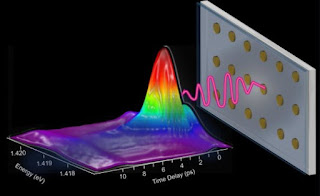Relaxor ferroelectrics are technologically important category of materials made up of ferroelectric materials that exhibit high electrostatics and their properties of a solid rely upon the arrangement of its atoms or molecules, which form a periodic crystal structure. At the point of Nano scale, arrangements of crystals that break this periodic structure can extremely change the behavior of the material and this is difficult to measure.
Using state-of-the art neutron and cyclotron X-ray scattering, scientists try to solve questions about relaxor ferroelectrics which are often lead-based. These materials have mechanical and electrical properties that are useful in applications such as measuring instrument and ultrasound and other applications. The non-conductor constants of relaxor ferroelectrics, that show their ability to store energy when in an electric field, have a rare dependence on the frequency of the field.
They can also have an extremely high piezoelectric property, which means that when automatically strained they develop an internal electric field, or, vice-versa they expand or contract in the presence of associate degree external electric field.
Properties help relaxor ferroelectrics useful in technologies where energy should be converted between mechanical and electrical. But lead is toxicant so scientists are trying to develop non-lead-based materials that can perform even better than the lead-based ferroelectrics. To develop these materials, they are trying to uncover aspects of the relaxor ferroelectric's crystal structure cause its unique properties. These breaks in the long-range symmetry of the structure play a crucial role in determining the material's properties. Using new instrumentation designed by operation scientists that is able to provide a much larger and more detailed measurement than previous instruments, the team studied the diffuse scattering of the materials, or how the native deviations in structure affect the otherwise more orderly scattering pattern.
Previous researchers have identified a certain diffuse scattering pattern, and associated it with the anomalous dielectric properties of relaxor ferroelectrics. When they analysed their experimental data, however, they found that the butterfly-shaped scattering was strongly correlated with piezoelectric behaviour. The scientists will use these discoveries to inform models of relaxor ferroelectrics that are used to develop new materials.
Future experiments will further illuminate the relationship between native order and material properties. For more details visit: https://crystallography.materialsconferences.com/
Contact:
Jessica Mark
Program Manager | Crystallography Congress 2018
Email: crystallography@enggmeet.com
Using state-of-the art neutron and cyclotron X-ray scattering, scientists try to solve questions about relaxor ferroelectrics which are often lead-based. These materials have mechanical and electrical properties that are useful in applications such as measuring instrument and ultrasound and other applications. The non-conductor constants of relaxor ferroelectrics, that show their ability to store energy when in an electric field, have a rare dependence on the frequency of the field.
They can also have an extremely high piezoelectric property, which means that when automatically strained they develop an internal electric field, or, vice-versa they expand or contract in the presence of associate degree external electric field.
Properties help relaxor ferroelectrics useful in technologies where energy should be converted between mechanical and electrical. But lead is toxicant so scientists are trying to develop non-lead-based materials that can perform even better than the lead-based ferroelectrics. To develop these materials, they are trying to uncover aspects of the relaxor ferroelectric's crystal structure cause its unique properties. These breaks in the long-range symmetry of the structure play a crucial role in determining the material's properties. Using new instrumentation designed by operation scientists that is able to provide a much larger and more detailed measurement than previous instruments, the team studied the diffuse scattering of the materials, or how the native deviations in structure affect the otherwise more orderly scattering pattern.
Previous researchers have identified a certain diffuse scattering pattern, and associated it with the anomalous dielectric properties of relaxor ferroelectrics. When they analysed their experimental data, however, they found that the butterfly-shaped scattering was strongly correlated with piezoelectric behaviour. The scientists will use these discoveries to inform models of relaxor ferroelectrics that are used to develop new materials.
Future experiments will further illuminate the relationship between native order and material properties. For more details visit: https://crystallography.materialsconferences.com/
Contact:
Jessica Mark
Program Manager | Crystallography Congress 2018
Email: crystallography@enggmeet.com

